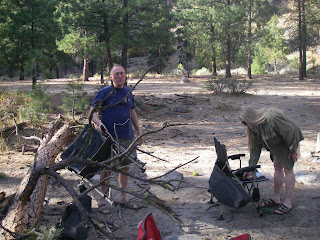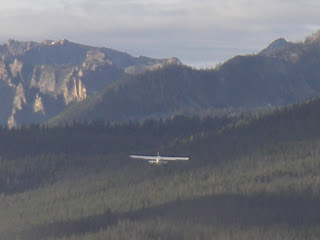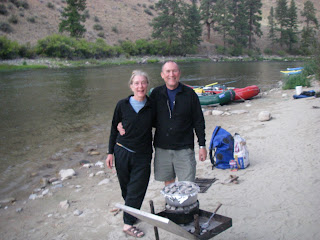 |
| Greg and Jan 20 years later in the grotto with their wedding T-shirts on ... |
 |
| Parrott's Grotto |
 |
| The water gets deeper and swifter in the Impassible Canyon |
 |
| Fish on! |
 |
| The snag that almost landed on Greg |
 |
| Whew! |
 |
| Yee-haw! Hello Middle Fork! |
 |
| Final approach to Indian Creek ... really excited now |
 |
| Taking off for the Middle Fork, banking by the Sawtooth Mountains |
 |
| Ready to roll at 7:45 a.m. at the Stanley airstrip with all of our gear |
Idaho's blessed with world-class rivers, and because of their popularity, it's tough to get a permit in the middle of the summer. But in the fall, after Labor Day weekend, it's easy to grab a launch permit -- if one is required at all -- and you can enjoy the September weather, solitude and great fishing.
Some friends of mine got married 20 years ago in Parrott's grotto on the Middle Fork of the Salmon River. We had hoped to do a wedding reunion trip in July, but no one in our group drew a permit from the lottery system, so we planned a September trip instead. You just have to hang loose and wait for the permits to become available on the www.recreation.gov web site, and snag one.
The hard part is finding a date that works for working people with kids in September. You've got to find someone to supervise the kids so they can stay in school -- that can be a tough one -- get time off work, etc. Plus, there might be other complications. So even though we had 18 people on the wedding party trip, our reunion trip consisted of just four people -- the honored guests, Greg Harley and Jan Sutter, my partner Wendy and me. That's cool ... I love small groups ... it makes things SO much simpler.
Considering all of the fall multi-day trip options in Idaho, the Middle Fork and the Main Salmon rivers involve the most logistics and expense. Floating Hells Canyon near Cambridge, the Lower Salmon Gorge near Whitebird or the South Fork of the Snake River east of Idaho Falls are easier to pull off, and no advance reservations are required. You just fill out a self-issue permit at the boat launch, arrange for a vehicle shuttle and go.
Besides the hassle of getting an advance permit on the Middle Fork, you also need to decide whether you're going to fly into Indian Creek (25 miles downriver to avoid low water and lots of rocks), and then arrange for a vehicle shuttle ($225 from Stanley to the takeout). We choose to fly into Indian Creek with McCall Air Taxi from Stanley to make things easier for our group. Most of the private groups we saw on the river started from the top, at Boundary Creek, because the water was a little higher this year (1.8 feet on the gauge). They ran small boats and packed lightly. One nimble group from Hailey floated in self-support inflatable kayaks backpack-style with no rafts to carry camp gear.
Admittedly, we chose the deluxe route. We wanted to eat like kings and queens on the wedding reunion trip (lots of Dutch oven meals), we packed champagne for the grotto, and the rafts allowed us to bring plenty of warm clothes for hanging out in the evenings and mornings.
(FYI - I've run the Middle Fork many times in late season at 1.8 feet or less without incident, but you have to focus like a laser beam on your line through rock-choked shallow areas, and be ready to leap out of the boat and push off rocks, which can lead to injuries. A friend of mine floated the Middle Fork the week before we went this year, and his boatmen were so weak and inexperienced, they just gave up on trying to steer around rocks after a while, and just drifted until they got stuck. They were totally exhausted by the time they reached Indian Creek.)
Back to the weather ... the first couple of days, the mornings were downright chilly, with temperatures just above freezing before sunrise. And then, when the sun popped over the high mountains guarding the river canyon, it warmed up in a hurry. There's at least a 30-degree temperature swing between 10 a.m. and 11 a.m. By noon, the temperatures were in the 80s, and the fish were biting on dry flies. Wa-hoo!
I have to mention one bone-chilling incident we experienced at Marble Creek Camp on Day 1. A 60-foot dead snag fell over in the afternoon after we reached camp and almost landed on Greg, who was hanging out in his lawn chair, reading on his Kindle. He was looking up at the tree and said to Wendy, "Hey, did you see that widowmaker up there?" Seconds later, the tree came crashing down, and Greg was quick enough to leap out the way!
A Shoshone-Bannock woman had given us a blessing before we launched at Indian Creek. Let me tell you, we all felt that her blessing may have made a difference, and we certainly felt blessed after that incident. The tree could have injured Greg or worse, and it could have landed on our camp table, wrecked dry boxes, etc. We were lucky!
On our last full day on the river, we pulled into Parrott's Cabin at 2 p.m. in the afternoon. We hiked up to the hidden grotto with the champagne and felt the mist of the tiny waterfall cascading over the rocks and into the cavern. It brought back a lot of great memories from 20 years before, and many other visits before and since. Best of all, Greg and Jan were all giddy and grinning from ear to ear. We soaked in the moment and had a big group hug.
And then a group of families showed up to see the grotto with their kids. The parents had taken their kids out of school for a week to enjoy the Middle Fork in September. Good for them, I thought! One of these years, I might do the same thing.
A few more notes on the Idaho's best multi-day trip rivers to run in the fall:
- Main Salmon wilderness section - Float from Corn Creek to Carey Creek, about 80 miles. Six days is best at low flow. After chukar partridge season opens on Oct. 1, this section can be productive for fall bird hunting. We saw a lot of chukars on the Middle Fork. Pick up a launch permit on recreation.gov.
- Lower Salmon Gorge - Float from Hammer Creek to Hellar Bar or arrange for a jet boat ride from the Salmon River confluence to Pittsburg Landing. Most people do this trip in 4 or 5 days in the fall. More days equal more leisure time. Wait until steelhead season opens, and it's a great cast-and-blast trip. Great section for chukar hunting as well. Only self-issue permit needed, available at the launch site.
- Hells Canyon - Put in at Hells Canyon Dam and float to Pittsburg Landing, about 35 miles. The cast-and-blast trip in Hells Canyon used to be kind of a secret. Nowadays, it's very popular. I will be doing my 22nd annual trip this fall in Hells Canyon in mid-October. Only self-issue permit needed, available at the launch site. Watch out for poison ivy and rattlesnakes.
- South Fork Snake River - Put in at Palisades Dam or other points downstream and float to Heise. Fly fishing for large native cutthroat trout and brown trout on this river is quite tricky because it's fished so hard nearly every day by a string of outfitters and private boaters. Most people zip through the standard canyon run in a day. Take your time, start at Palisades, and enjoy camping along the way in large cottonwood groves. Do your research about the best flies to use. The fish are picky.
If you don't have your own river boat, there are numerous outfitters who offer trips on the rivers I've mentioned here. Go to www.ioga.org to look for an outfitter that suits your needs and budget. Outfitters will know what flies and lures work best for fishing, and they also offer bird-hunting trips. Look for hot deals!
Have fun!
- SS
 |
| Greg and Jan made a chicken casserole and blueberry cobbler at Shelf Camp on Day 2 |














